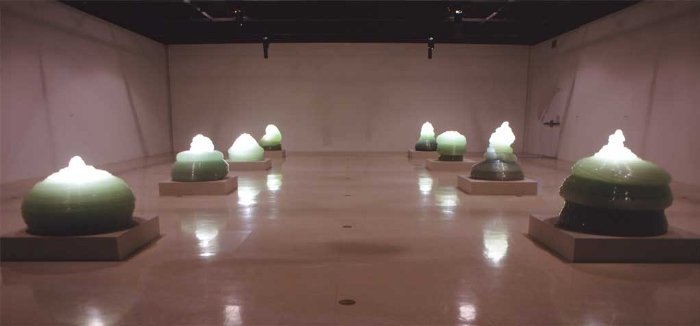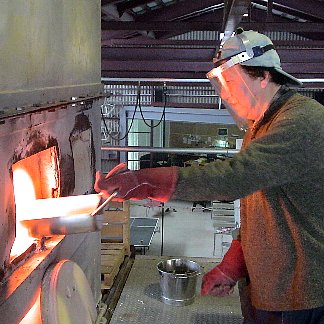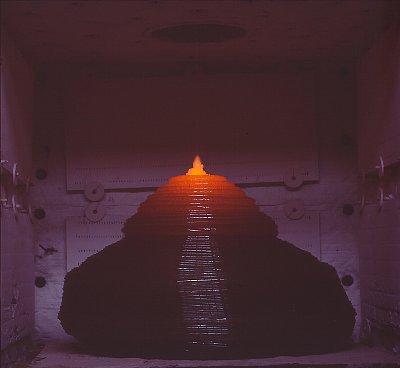| The News Tribune - Tacoma, WA Friday, July 2, 2004 |
 |
| Japanese artist Kazuo Kadonaga's hands-free process makes each of
his glass sculptures unique. The art shown above was part of a 2002exhibit at the San Diego State University Art Gallery |
| DON'T TOUGH By Jen Graves, For Japanese artist Kazuo Kadonaga, part of the process is letting the glass sculpt itself "Glass likes to be molten, so he's essentially letting the materials be the materials." |
 |
| in 2003, Kadonaga checks the temperature on the femace full of glass while it drips dow into a kiln below in his stydio. |
The News Tribune Human hands do not touch Kazuo Kadonaga's dripped-glass sculptures as they're being made. For these green-tinged, glowing mounds that freeze the material's molten memory, glass itself is the artist.
The Japanese artist is in residence at Pilchuck Glass School in Stanwood this summer, and he'll demonstrate his techniques at the Museum of Glass: International Center for Contemporary Art from Wednesday to July 11. He is one of several artists-in-residence from Pilchuck at the museum this summer.
But he could not differ more from Pilchuck-based Northwest studio glass, with its roots in Italian traditions that prize daring, skill, brilliant color and beauty. Since his start in glass in 1 990, Kadonaga has used only colorless industrial window glass. Whereas blown pieces require rapid, balletic teats, Kadonaga's piles of glass accrue on their own, requiring only minimal observation. And whereas traditional glass masters pursue perfection in form and push the material to a precarious thinness, every one of Kadonaga's piles is different from the last, and many of them, weighing more than a ton, splinter and crack in the making.
Here's Kadonaga's automated setup: A furnace full of hot glass is set 10 feet above a computer-controlled cooling kiln. Over 48 hours, the furnace pours a continuous string of the glass into the kiln through an opening in the kiln's top, onto a steel plate inside. Then, to avoid excessive cracking, the enormous pile spends the next 100 days cooling. Kadonaga can make only three pieces per year.
The variations result from the studio's air temperature, humidity and airbome pollutants acting on the glass's flow. Kadonaga values the random elements. More than half his pieces have significant cracks. To him, those are still complete, but they're not seen often because they're not transportable to far-flung exhibitions. Outside his native Japan he has shown all over the United States in Mexico and throughout Westem Europe.
Kadonagafs, 58, will not be showing finished works at the Museum of Glass, but instead will be creating pieces in the hot shop using a modified version of his furnace system. He'll also demonstrate a new bubble-based blowing process he developed at Pilchuck this summer.
The bubble technique is his first deviation from the pouring process he invented after experimenting with glass for years.
"He did many, many experiments, none of which interested him, until he hit on the glassness of glass - how glass is different from other materials," said Josine ianco Starrels, who first showed Kadonaga's works in wood when she was director of the Los Angeles Municipal Art Gallery in the 1980s.
Kadonaga works with one material at a time. Before glass, he used wood, paper, bamboo and silk. For each material, his purpose is simple: to let it speak in its own natural language, not to use it as his megaphone. The impulse falls into the 1970s Japanese art movement mono-ha, or school of things, which used naturally occurring or found materials to explore the human relation to the material world. Kadonaga, speaking recently by phone through a translator, said he is also influenced by American minimalists Carl Andre and Donald Judd and the process-oriented artist Sol Lewitt. If the sculptures hold interest, Kadonaga says, it is only because the material of glass itself is interesting. He is the director, not the actor.
"Glass likes to be molten, so he's essentially letting the materials be the materials," said Scott Lawrimore, gallery manager and curator at Greg Kucera Gallery, which showed Kadonaga's sculptures in January 2003.
 |
| This 2002 sculpture by Kazuo Kadonaga, which weigh more than a ton when it is finished, is pictured in the process of dripping down from a fumace above into a heated kiln. |
Kucera broke his own rules to accommodate the conceptual glass, Lawrimore said.
"We don t show glass here " Lawnmore said. "Because Kazuo's work transcended what we thought of as studio glass - that's why we showed it."
Ianco Starrels curated the exhibition of his glass that made several American stops in 2002, including at the Schneider Museum of Art at Southern Oregon University in Ashland. She admires the way his haphazard glass piles evoke the material's ancient origins. According to an account by the Roman historian Pliny, Phoenician sailors built a beach fire using alkali blocks they were carrying as cargo, fell asleep when the fire was still burning and found the next morning a solid substance that looked liquid: glass.
The sculptures have been compared to taffy, stalagmites and swirls of ice cream. Ianco Starrels calls them "fat and juicy-Iooking ... Sumo wrestlers."
But what they look like above all, she says, is glass.
"He was able to show vs the natural identity of glass," Starrels said.
And "glass," Kadonaga said "has a mind of its own."
Jen Graves, 253-597-8568 jen. graves@mail. trtbnet. com